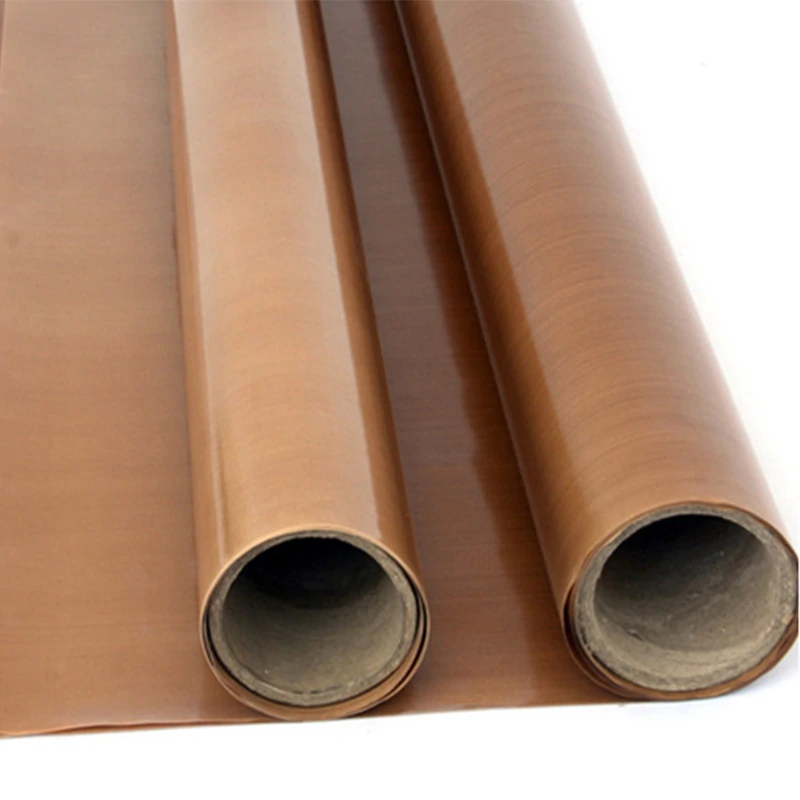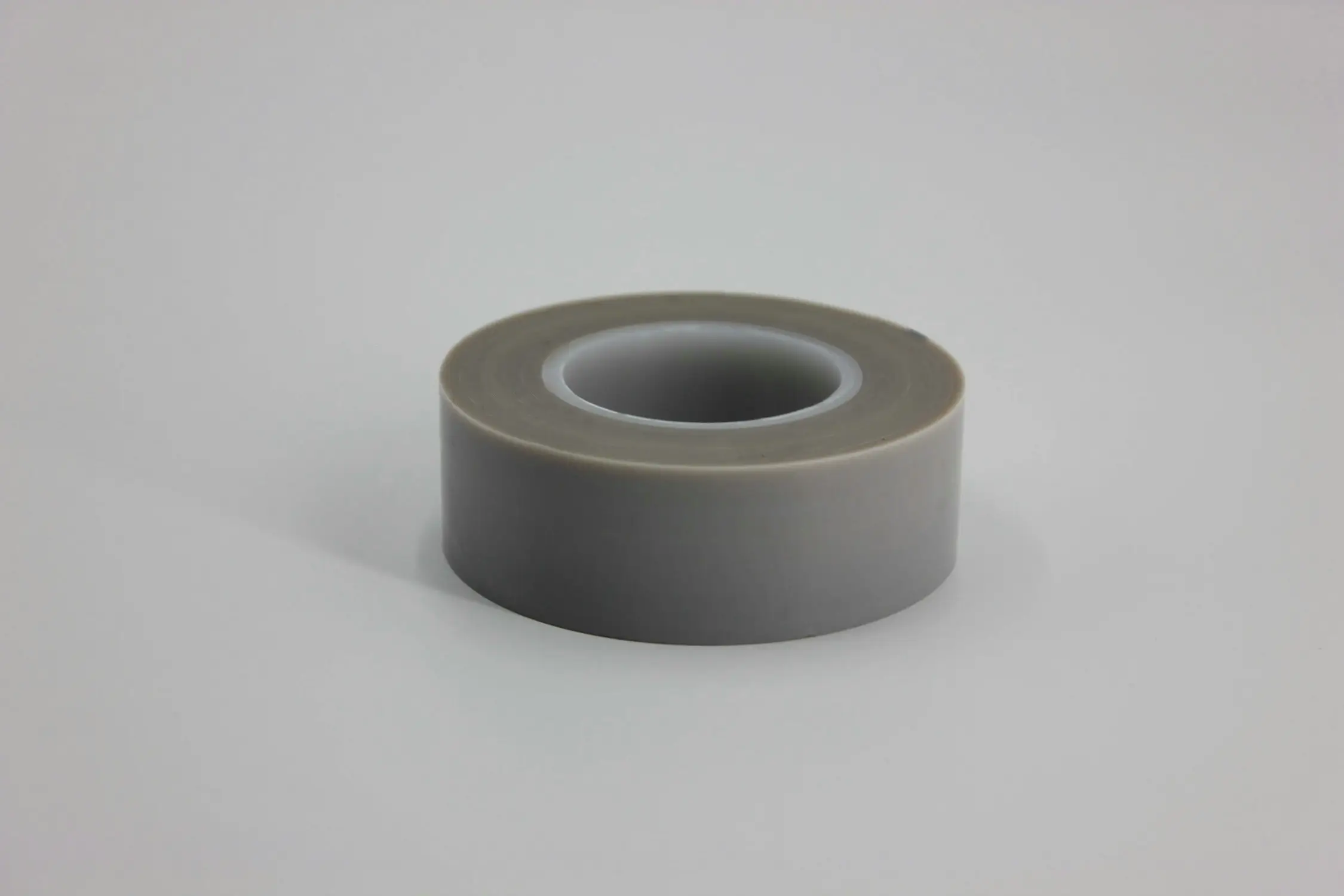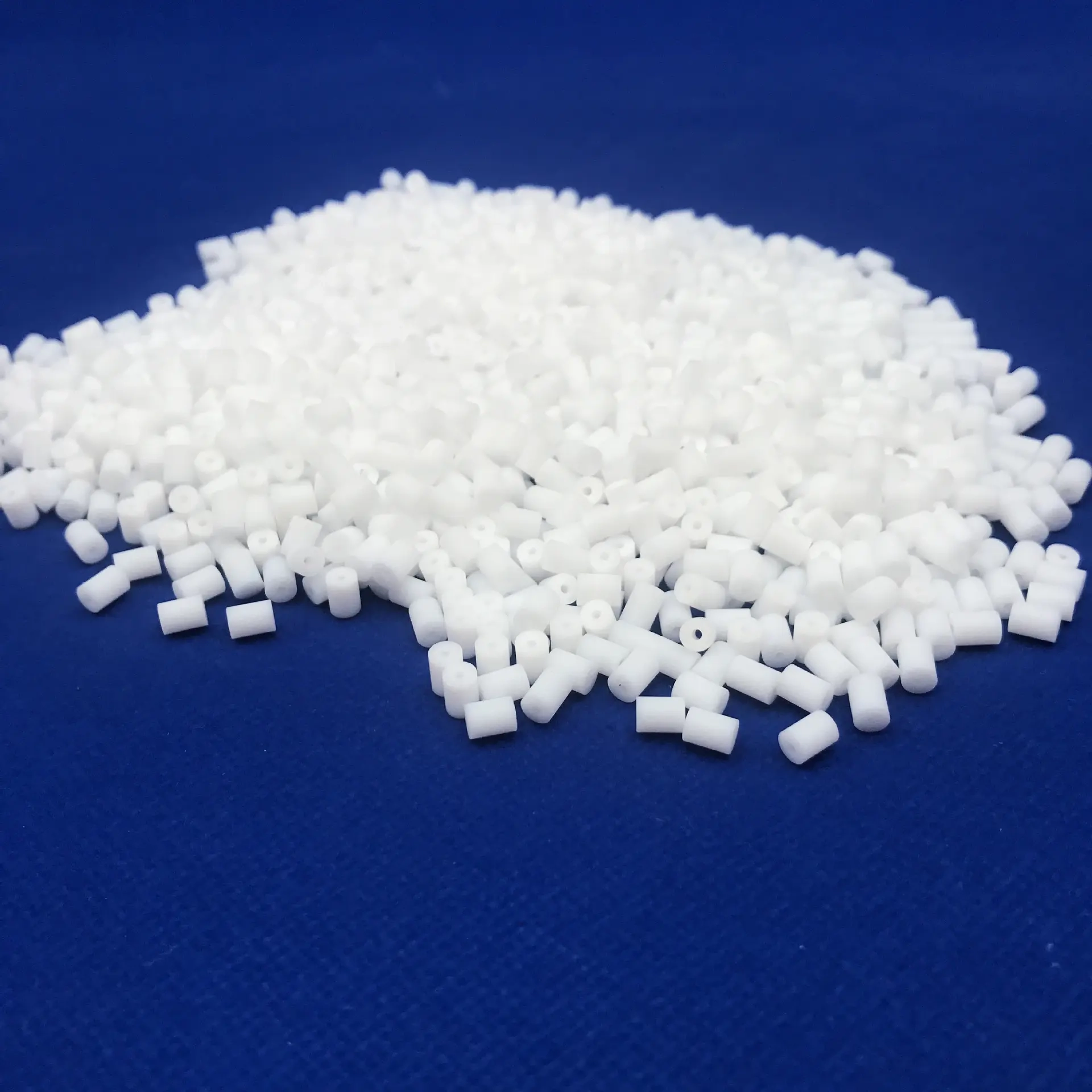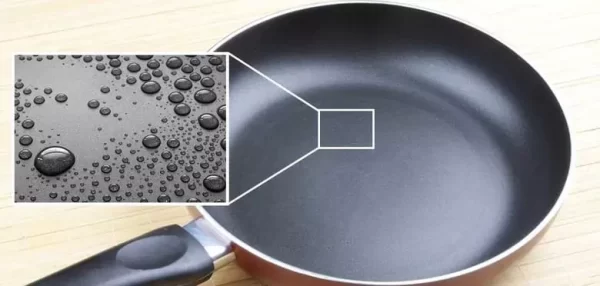Non-stick pans, often recognized by their Teflon non-stick coatings, have been a popular choice in kitchens worldwide due to the convenience they offer while cooking and cleaning. These pans are designed with a specialized non-stick material, ensuring that food effortlessly glides on the surface, eliminating the need for excessive oil or fat. This Teflon non-stick pan feature not only promotes healthier cooking but also simplifies the post-meal cleanup process.
How do non-stick pans work?
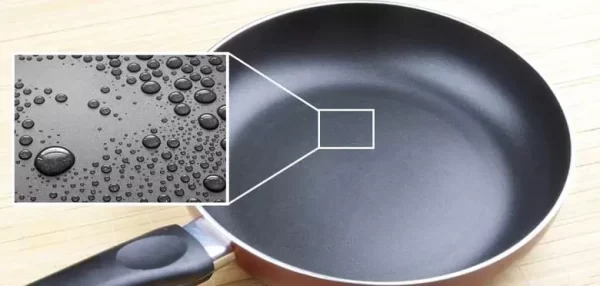
Non Stick Pan
At the core of the modern teflon non stick pan material is the application of non-stick coatings. This non stick coatings provides a super-smooth barrier on the cooking surface, ensuring that the food doesn’t adhere to it. Whether you’re frying an egg or searing a steak, this innovative nonstick coating promises a hassle-free experience.
Teflon:
The most well-known non stick coatings is PTFE (PolyTetraFluoroEthylene), commercially known as Teflon. A teflon non-stick pan boasts a coating non-stick pan enthusiasts have grown to love. This is primarily because the nonstick coating of Teflon possesses a unique molecular structure. The almost frictionless surface makes it incredibly challenging for food molecules to bond or “stick” to it. It’s akin to trying to pin a note to a stream of water – virtually impossible!
Is All Non-Stick Teflon?
While Teflon reigns supreme in the realm of non-stick pan material, it’s essential to note that not all non-stick coatings are made of Teflon. The query “is all non stick teflon?” often comes up. And the answer is no. There’s a wide array of non-stick pan materials available. Some alternatives utilize different kinds of cookware coatings, offering various benefits.
The nonstick coating is meticulously applied to ensure evenness. Multiple layers are often sprayed onto the pan, which are then cured to create a sturdy, long-lasting non-stick surface. This ensures that the non stick coatings forms a bond with the pan’s base material, making it durable and efficient.
Moreover, innovations in cookware coatings mean there are now pans with multiple layers of non stick coatings. This not only enhances the longevity of the nonstick surface but also ensures better cooking
What is Non-Stick Coating Made Of?
1.PTFE:

Non Stick Material
Polytetrafluoroethylene, commonly branded as Teflon, stands at the forefront of nonstick coatings. But what does Teflon look like? Imagine a synthetic polymer where carbon and fluorine dance together, creating a slippery, non-reactive surface perfect for those teflon non-stick pans.
Essence of PTFE:
High-Temperature Resistance: PTFE coatings can withstand high heat, making them perfect for frying pans and other cookware.
Chemical Resilience: It remains unreactive to most chemicals, ensuring the coating on a non-stick pan remains untarnished over time.
Safety Concerns Addressed: Modern PTFE, especially in teflon cookware, is manufactured without perfluorooctanoic acid (PFOA), making it safer for culinary adventures.
Learn more about《Know what is PTFE coating?》
2.Beyond Teflon: Diversifying non stick coatingss
While PTFE reigns supreme, it’s not the sole component in every non-stick pan material. The market has seen diversification, with manufacturers exploring materials beyond Teflon.
Ceramic Coatings: Derived from the sol gel process, ceramic coatings provide an eco-friendly, PFOA-free alternative. These often manifest as the white or cream-colored ceramic pan, heralded by many as a natural, non-toxic choice.
Anodized Aluminum: This involves electrically hardening the aluminum, resulting in a non-stick surface that’s both scratch-resistant and durable.
Cast Iron: Seasoned cast iron skillets, with proper care, can emulate a nonstick surface. They are a favorite among chefs for their heat retention and distribution properties.
3.The Art and Science Behind Cookware Coating
The application of non-stick coatings on pots and pans is an intricate process. Initially, the cookware coating base, be it anodized aluminum, cast iron, or another metal, undergoes pre-treatment. This ensures proper adhesion of the non stick coatings. Subsequently, layers of the nonstick coating are carefully applied, typically using a spray, and then cured at high temperatures to create that desired non-stick surface.
What Is the Coating on a Nonstick Pan?
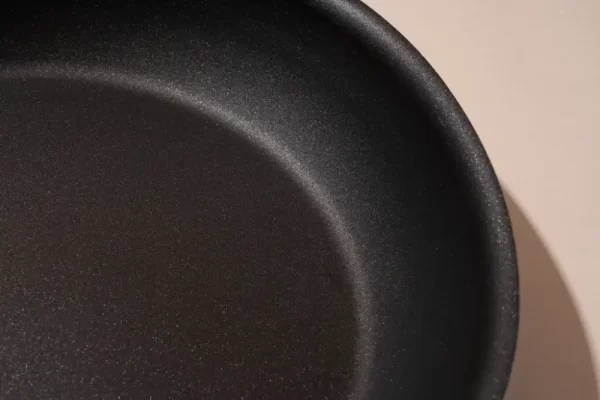
Non Stick Surface
The rise of the non-stick pan has revolutionized modern cooking. But how often do we pause to ponder nonstick frying pans what makes these frying pans truly “non-stick”? At Aokai, our expertise in PTFE products provides a vantage point to shed light on this culinary marvel. Let’s unravel the intricacies of non-stick coatings.
Learn More: 《What Is the Coating on a Nonstick Pan?》
The Reign of Teflon:
When you think of a teflon non-stick pan, what comes to mind? Likely, it’s that sleek, buttery-smooth non stick surface where eggs slide effortlessly, and pancakes flip with ease. But what does Teflon look like beneath this surface?
The Teflon Marvel: Essentially, Teflon is a brand name representing the PTFE coating – a white, waxy solid at room temperature. When applied as a cookware coating, it transforms into that iconic slippery non-stick surface we all adore.
Diverse Utility: Beyond pots and pans, this nonstick coating graces various kitchen tools, illustrating its versatility.
FAQ: Are all non-stick pans made of Teflon?While Teflon was a pioneer, the world of non-stick coatings has expanded to include other materials. However, the phrase “Teflon pan” remains ingrained in our culinary lexicon due to its early dominance.
Beyond Teflon:
As technology advanced, so did the quest for the perfect non stick coatings. Today’s market is flush with alternatives:
Ceramic Coatings: Born from a sol-gel process, ceramic provides an eco-friendlier non-stick solution. Many home cooks cherish ceramic for being PFOA-free.
Silicone and More: While less common for stovetop cooking, silicone offers a unique non-stick surface for bakeware.
Yet, a question lingers: What are non-stick pans made of, primarily? The answer varies based on brand and type, ranging from PTFE coatings to ceramic and beyond.
What is non-stick coating made of?
To truly appreciate the modern marvel that is the nonstick pan, we must unravel the layers, both literally and figuratively, that make up this essential kitchen tool what are non stick pans made of.
1.The Nonstick Coating – Beyond Just Teflon
While many assume that all coating non stick pan are “Teflon pans,” the truth is more varied and intriguing:
Teflon (PTFE) Coating: This is a synthetic polymer that, when applied to the surface of a pan, creates a slippery, non-reactive surface. However, concerns arose regarding perfluorooctanoic acid (PFOA), once used in the production of Teflon. Today, most reputable manufacturers, including Aokai, produce PFOA-free Teflon coatings to ensure that your cooking is safe.
Ceramic Coatings: A newer entrant to the nonstick market, ceramic coatings offer a naturally nonstick surface. They are derived from a sol-gel process that converts a solution into a gel-like substance which is then applied to the pan. Once cured, this forms a hard, nonstick surface. Ceramic coatings are often praised for being free from potential harmful chemicals and can withstand high heat, making them popular among eco-conscious consumers.
Silicone Coatings: While less common, silicone is sometimes used, especially in bakeware, for its nonstick properties.
2.Deal with
To enhance the pan’s functionality and longevity, many are finished with external coatings and treatments:
Hard-Anodized: This process makes the aluminum more durable, non-reactive, and provides a matte finish.
Stone or Granite Derived Coatings: These are newer innovations, infusing a blend of stone particles into the nonstick coating to enhance durability and offer a unique aesthetic.
3.The Base of the Pan
The heart of every nonstick pan lies in its core, which is typically made from several nonstick materials:
Anodized Aluminum: A popular choice, anodized aluminum undergoes a process that makes it harder and non-reactive. This ensures an even distribution of heat, which is critical for cooking perfection.
Stainless Steel: Known for its durability and resistance to staining, stainless steel often features in high-quality nonstick pans. It’s frequently combined with other materials, like a layer of aluminum, to enhance heat distribution.
Cast Iron: A classic, cast iron pans have been in kitchens for centuries. Modern nonstick versions combine the heat retention properties of cast iron with a nonstick surface, offering the best of both worlds.
What Does Teflon Look Like?
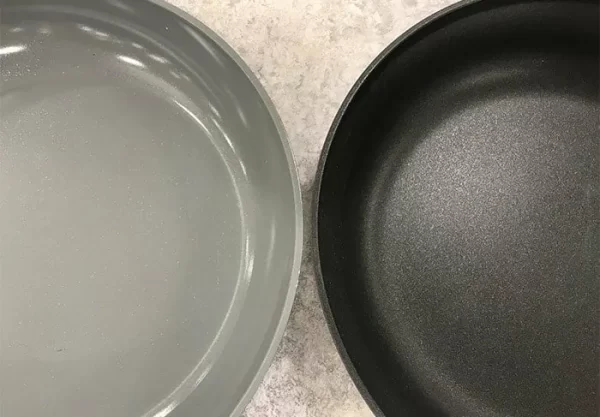
What Does Teflon Look Like
1.The Birth of Non-Stick Cookware
The revolution in modern cooking began with the advent of non-stick coatings. Imagine a world where eggs slide right off your teflon non-stick pan or where crepes don’t glue themselves onto the cooking surface. Thanks to these nonstick coatings, home cooks and professional chefs can experience a hassle-free culinary journey. Yet, many often wonder, what does Teflon look like? And what is it made of?
2.Teflon: More than Meets the Eye
At its core, Teflon boasts a smooth, slick, often white or off-white non-stick surface. It feels distinct — silky yet sturdy. However, the magic lies deeper. Teflon, which many associate directly with non stick coatings, is derived from a broader family: Polytetrafluoroethylene, or PTFE. But not all non-stick pan material is pure Teflon. So, when someone asks, “is all non-stick Teflon?”, the answer is nuanced.
3.Evolution of Non-Stick Pans
The first teflon non-stick pans showcased a smooth, almost glossy finish. This non-stick surface ensures that food doesn’t adhere, eliminating the need for excessive oils. Modern variations, however, incorporate various cookware coatings. While Teflon dominated the non-stick pan material market initially, today, we see a rise in ceramic coatings, sol-gel based approaches, and more. Yet, the primary intent remains — to provide a superb non-stick surface.
How do I know if my pots and pans are made with Teflon?
Teflon is a brand name for a type of polytetrafluoroethylene (PTFE) which is most commonly known for its non-stick properties in cookware. Identifying if your pots and pans are coated with Teflon or a similar PTFE-based material is essential for understanding care requirements and potential safe to cook,health concerns. Here’s a quick guide to help you determine this:
Visual Inspection: Teflon-coated cookware typically has a smooth, shiny, and dark (usually black) surface. The non-stick layer will look uniform and can be distinct from the metallic base if there’s any chipping or wear.
Manufacturer’s Information: The easiest way is to check the bottom of the cookware or the accompanying paperwork for brand names or indications. Terms like “non-stick”, “PTFE”, or “Teflon” are clear giveaways.
Water Test: Drop a few droplets of water onto the pan’s surface. On a Teflon-coated pan, the water will bead up effortlessly and slide around, thanks to its non-stick nature.
Feel: Run your fingers over the surface. Teflon coatings offer a distinctly smooth feel compared to uncoated metal or cast iron.
Age and Usage: Teflon coatings can wear over time. If you notice parts of your cookware’s surface chipping or peeling, revealing a different material underneath, it might indicate a worn-out Teflon layer.
In summary, while many pans may appear similar at first, subtle clues, from surface texture to manufacturer markings, can help you determine if they contain Teflon or a similar non stick coatings.
Is Nonstick Coating on Cookware Proven Safe?
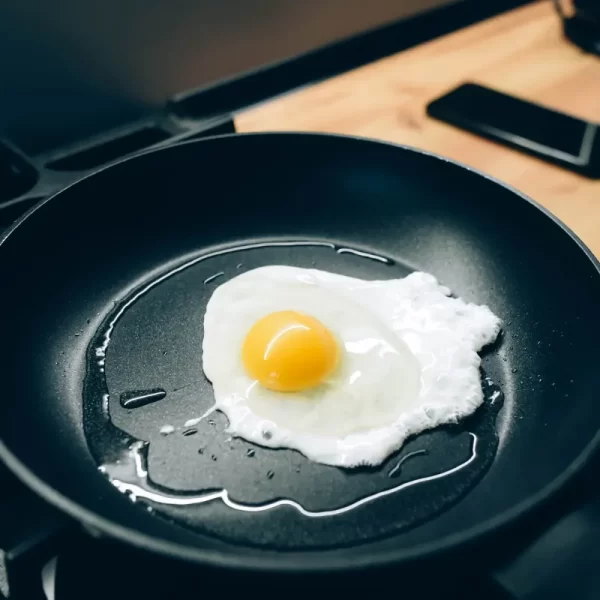
Safe to Cook
Over the years, nonstick cookware has revolutionized the culinary world, offering an unparalleled ease of cooking and cleaning. But amidst the convenience, concerns regarding the safety of nonstick coatings have surfaced. Let us delve deep into understanding the safety of these coatings with an expert lens, presenting an analysis that is both deep and clear.
Before we address the core question, it is vital to understand what nonstick coatings are made of. These coatings primarily consist of a material known as polytetrafluoroethylene (PTFE), a type of polymer that has numerous applications, including in products like PTFE cloth and non-stick baking mats.
PTFE:
A common misconception is that PTFE coatings are unsafe. However, when used under normal cooking conditions, PTFE coatings do not release harmful substances, making them a safe option for modern kitchens.Teflon non stick pans, which popularized nonstick coatings, have been a staple in kitchens worldwide. Understanding its structure and properties will provide a clear picture of its safety parameters.
The PFOA Controversy:
A primary concern with Teflon, a brand that used to manufacture PTFE coatings, arose due to the use of pfoa free(PFOA) in the production process. PFOA, a substance linked with various health issues, has been completely phased out of the manufacturing process since 2013, ensuring the safety of the nonstick coatings used today.
Learn more about《Why is Teflon Still Being Used?》
Ceramic Coating:
For those looking for alternatives, ceramic coatings have become a popular choice. These coatings, which are PFOA-free, offer a safe and efficient non stick surface for cooking food, without the concerns associated with older nonstick products.
PTFE in Aokai Products:
As a renowned manufacturer, Aokai offers products like non-stick baking mats and silicone coated fiberglass cloth, that adhere to stringent safety standards, making them a preferred choice for conscious consumers.
Quality Assurance: The Aokai Promise
At Aokai, we prioritize safety above all. Our products undergo rigorous testing to ensure they meet the industry standards, offering a safe and reliable solution for both professional and home cooks.
In the ever-evolving landscape of nonstick cookware, safety has taken the forefront. Through continuous innovation and strict adherence to safety protocols, manufacturers like Aokai are ensuring that nonstick coatings are not only convenient but also safe for everyday use.


